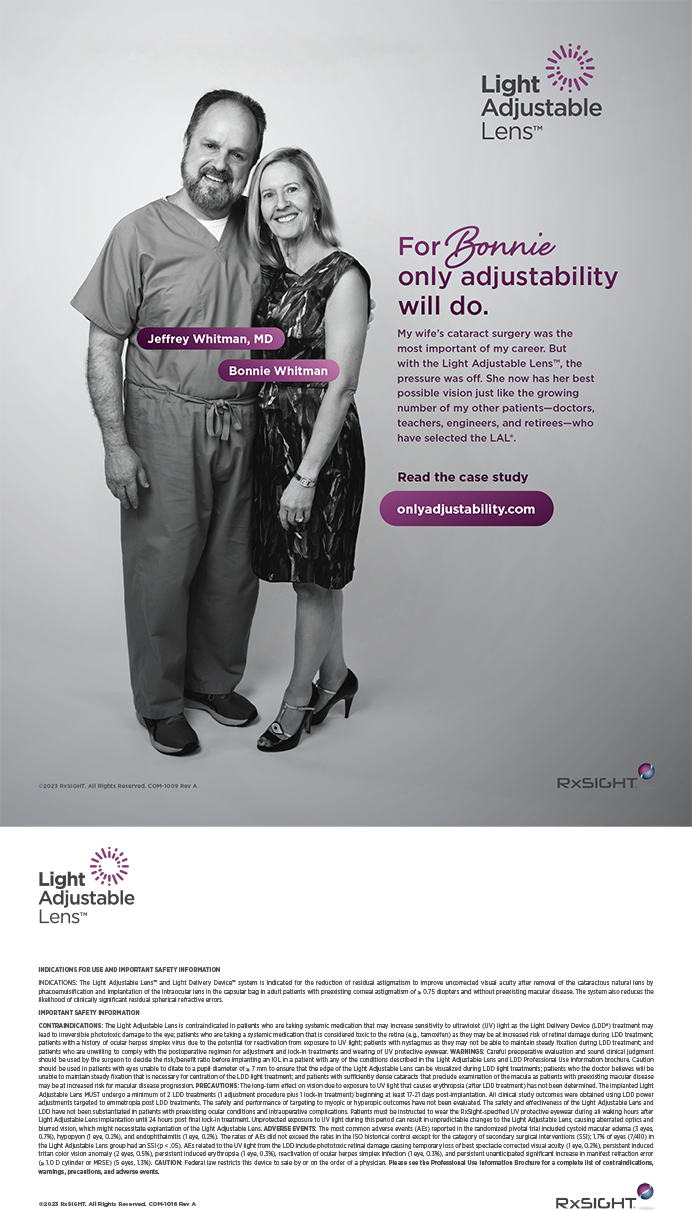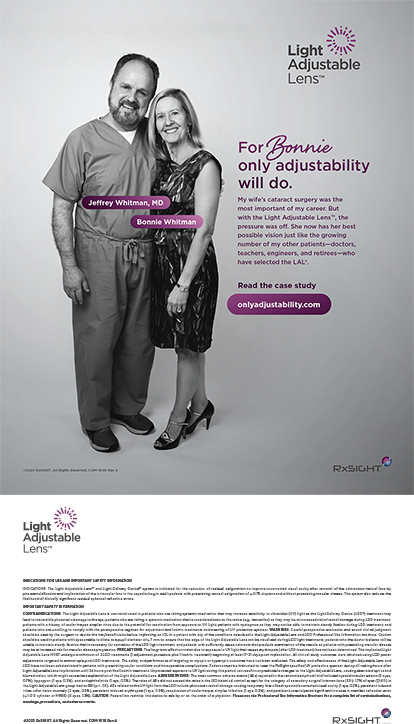Not every innovation that sounds exciting actually makes it in the OR. Promising technologies can fall short, patients can balk at high costs—as can surgeons—and old habits can be hard to change. Which of today’s treatments can overcome these barriers? CRST asked six surgeons to discuss new treatments they’ve embraced, what they’re still not ready for, and what it would take to change their minds.
CORNEAL INLAYS

James C. Loden, MD: I have elected not to perform corneal inlay implantation, and I don’t see them gaining traction. They are gaining little to no momentum in the Nashville market, and I attribute that to poor outcomes and high cost.
The literature shows a wide range in outcomes, from uncorrected near visual acuity of J1 to J10. How would you like to be the patient who paid $5,000 and can read only J5, much less the one who reads J10? My patients are not satisfied unless they are able to read J3 or better. I simply can’t promise that, based on my research on inlays. I feel that this near vision under-performance is under-reported, as are issues with photopsia.
To offer inlays, you need a femtosecond laser for implementation, and you must select patients who have ideal spherical refraction. Patients with the ideal refraction seem to rarely walk in off the street, so most patients require LASIK before the inlay is implanted. This entails many costs, including chair time for pre- and postoperative care, the femtosecond laser, the excimer laser, the inlays, and an ocular scatter index analyzer such as the HD Analyzer (Visiometrics). All of this makes it hard to reach critical mass for profitability.

Michael Patterson, DO: Corneal inlays allow people to become free of spectacles at a time in life when they previously could not. Many people were able to have LASIK or PRK and become spectacle independent from age 15 to 40 years, but once they hit their mid-40s they began reaching for reading glasses. The advent of corneal inlays has potentially changed the game. People can now have whatever vision they want without glasses or contacts.
The major barrier at this time is the equipment required to use these devices. With the Kamra corneal inlay (CorneaGen), you need a specific laser that many centers do not have. You would be required to purchase this laser on top of trying to make money off the device. The Raindrop (ReVision Optics), which is no longer available, required a LASIK laser. The cost of the inlay procedure is also a barrier for patients.
For me to use corneal inlays, I would need to see a better safety profile. The rate of explantation and risk of haze are not low enough to use this technology instead of refractive lens exchange (RLE). Our results with RLE are fantastic, and the procedure leaves the cornea alone. I do not perform inlays at this time but will be looking forward to potentially diving in later.

Blake K. Williamson, MD, MPH, MS: There are many positive attributes to the idea of corneal inlays, which drove me to carve out a space for them in my practice. First, presbyopia correction continues to be the holy grail in refractive surgery, and the prevalence of dysfunctional lens syndrome is massive—I’m for any procedure that can help surgeons correct this problem for their patients. I agree with those who have predicted that presbyopia will become its own subspecialty one day. We all have patients in their 40s and early 50s who may be a little too old for LASIK and a little too young for cataract surgery. Perhaps they see well at distance and are only looking to reduce their need for readers, which they believe make them seem older.
In the past, the only options we had were binocular blended vision (ie, monovision) which has known issues with lack of stereopsis and depth perception, or dysfunctional lens replacement with presbyopia-correcting IOLs, which is more invasive and has side effects associated with multifocality. The ability to slip an inlay into the cornea with a quick, painless procedure and give patients the near vision they want without disrupting stereopsis or having to go through a more invasive surgery or neural adaptation process has benefits. These are the reasons I chose to adopt the Raindrop inlay when it was available, and I was sad to see that technology and the wonderful team at ReVision Optics go. Although I had good results, it wasn’t perfect and there are definite barriers for many surgeons looking into corneal inlays.
The first barrier is economics, as corneal inlays are not covered by insurance and some surgeons feel uncomfortable talking about cash-pay procedures or managing the expectations that come along with them. I believe the economic piece is more of a burden on the surgeon and his or her mentality than it is on the patient. I live in a lower-income, small market, yet I still do plenty of refractive surgeries, so the myth that patients in my town won’t pay for this is just that—a myth.
The second barrier is the lack of a refractive mindset among some surgeons. Rather than learning new procedures that can reduce or eliminate their patients’ needs for glasses, some surgeons choose to stick with what they learned in residency. My hope is that this will change as technology continues to improve and provides more predictable outcomes as the younger generation of surgeons becomes busier in the refractive space.
The third barrier is history. Placing something into the cornea to achieve a desired refractive effect is not a new idea. Many surgeons have seen procedures like this come and go, and this explains their desire to take a wait-and-see approach.
The fourth and perhaps most notable barrier for refractive surgeons considering adopting inlays is that the labeling for them has been prohibitive. They were approved only for use in plano presbyopes. We call plano presbyopes unicorns at Williamson Eye because we almost never see them. There is understandably some trepidation about placing a foreign body into the pristine cornea of a patient whose UCVA is 20/20. After all, inlays are not totally benign: Haze, dislocations, and explantations have been reported. That said, the frequency of many of these complications has been reduced as early adopters have fine-tuned protocols with more refined operative plans, enhanced laser algorithms, updated postoperative pharmaceutical regimens, and off-label techniques such as concomitant LASIK and the use of mitomycin C.
For me to get started again with inlays, I really want to see excellent long-term safety data and excellent consistency with near visual outcomes that don’t sacrifice distance vision.
I believe these must approach LASIK-like outcomes for inlays to take off, and, right now, we aren’t there. But I’m hopeful, and I look forward to emerging technologies such as allogenic grafts from Allotex.
Finally, I would like to see data showing the benefits of inlays in pseudophakic patients. It seems to be a weekly occurrence that a pseudophakic patient, whom I counseled extensively preoperatively on refractive options, tells me: “I can’t stand these reading glasses. I wish I had gone for the lens that provides near vision too.” Being able to offer these patients a second chance at near vision correction is something I think could be a windfall for patients, doctors, and industry.
CXL
Dr. Loden: CXL is truly the new standard of care for keratoconus. It is rare when we have a treatment that prevents a disease from inducing morbidity. Typically, physicians are trying to fix a problem that has already occurred or trying maintain the status quo. With early intervention, we can now arrest keratoconus and eliminate the need for corneal transplantation and cumbersome rigid gas permeable (RGP) or scleral contact lenses.
I know because I have keratoconus. My best corrected vision is obtained only with RGP contacts. Boy, do I wish I had had access to CXL 25 years ago! If I had, I could have stayed in soft toric contact lenses or glasses. I recently underwent off-label, epithelium-on (epi-on) CXL in my right eye because I was concerned that my cone was progressing despite being 52 years old.
I find the state of CXL in the United States to be on the verge of government-induced malpractice. We are light years behind our colleagues outside the United States. CXL is a vitamin eye drop combined with not much more than a tanning bed light, yet our government feels compelled to save the population from the possible effects.
Cost is a huge barrier, as the approved formulation of riboflavin is now so exorbitantly priced that we can’t afford to use it on our cash-pay patients. On the other hand, insurance companies will rarely pay for the procedure. When they do, the reimbursement for this hour-long treatment is not sufficient to warrant a high-volume refractive cataract surgeon spending that amount of time for one case. (Editor’s note: For an update on reimbursement, see Reimbursement for CXL: Current Status and Best Practices, in the July 2018 issue of CRST, pg 47.)
It is often forgotten that CXL can be used to treat infectious keratitis. This has now become a standard of care for nonresponding infectious keratitis in my practice. All of these treatments are done off-label with special informed consent and cash payment. We have seen some amazing outcomes from the perspective of keratitis resolution and prevention of infectious melts.
Dr. Patterson: Positive attributes of CXL have been shown in multiple studies. The procedure is clearly advantageous in stabilizing the cornea. The main issue is that most patients in our practice don’t have keratoconus. To initiate CXL in our practice would make no sense, as we couldn’t perform enough cases to make the money to pay for the devices. I have held off on CXL due to a lack of demand for the procedure. At this time, I think this is a procedure for tertiary referral centers or practices in larger cities.

Audrey R. Talley Rostov, MD: I participated in the CXL USA trial and had excellent results with epi-on CXL. I am now offering epithelium-off (epi-off) CXL with the Avedro unit due to limitations that were placed on the CXL study. This was working well until Avedro increased the cost of its riboflavin (and thus the card that you need to activate the machine for each treatment) from $600 to more than $2,100. This per-procedure increase has forced us to raise our price, and the procedure is now out of range for many patients who do not have insurance coverage. Avedro raised the price to increase its revenues and theoretically encourage insurance coverage, but only the former has occurred. (Editor’s note: For an update on insurance coverage for CXL, see Covering the CXL Procedure.) When we try to obtain information on the company’s programs to help patients pay for the procedure, it becomes an onerous task, and we end up losing revenue in the form of time and uncollected costs for the procedure. Before Avedro increased the fees, it was working quite well. It is also frustrating that we can’t have easy access to the epi-on technique.

P. Dee G. Stephenson, MD: This has been a great FDA approval for treatment of patients with keratoconus, for unstable corneas in patients with previous RK surgery, and for patients with ectasia after LASIK. I do not own the laser to do this, and I will not purchase one because I do not see enough patients with keratoconus. However, this gives postrefractive surgery patients an option to strengthen their corneas before cataract surgery. There is a practice near me that has this technology.
The patient’s financial outlay for this treatment is high, which limits its widespread use. It is a small niche that is best handled by cornea specialists or refractive surgeons.
LASER CATARACT SURGERY
Dr. Loden: The public is demanding laser cataract surgery in many urban and rural markets. In my Nashville practice, between 47% and 53% of cataract procedures are now performed with the femtosecond laser. We recently installed a femtosecond cataract laser in my rural practice, a 2-hour drive away from Nashville, serving a population of 10,000. Within 1 month of launch, that practice was on track to perform more than 30 laser upgrades per month. Prior to having the laser, we were performing fewer than 12 per month on average.
The major obstacles to laser cataract surgery are cost and time. If your volume is less than 20 eyes per month, your costs will eat your profits. The other cost is access to an excimer laser to provide patients with the spectacle independence that they demand.
Laser time may be only 2.5 minutes, but that isn’t the real time. No matter what anyone says, it still takes 7 to 8 minutes to get to the laser, perform a time out, dock the eye, perform the treatment, and then walk to the next room. Highly skilled surgeons in high-volume practices have to get accustomed to this time and loss of caseload per day unless a laser shooter is used, essentially employing another surgeon to perform the laser portion of the procedure.
Dr. Patterson: We performed laser cataract surgery for 4 years in our facility, but we recently decided to stop. The annual cost to maintain the laser, which was as high as $40,000 per year, was prohibitive. The number of laser cataract surgeries needed just to break even was high. Furthermore, our own clinical data did not show that the laser offered safer, more efficient, and better-quality results. If these kinds of results were to be proved, I think we could expect to see a dramatic shift in the treatment process. We could potentially try implementing laser cataract surgery again if it becomes economical for both the doctor and the patient.
Dr. Talley Rostov: If more companies would cap the amount we spend on per-procedure fees, there would be greater adoption of laser cataract surgery. It would be more accessible for some of our complex patients who could benefit most because more surgeons could consider using an all-laser platform.
Dr. Stephenson: This has been a great addition to my practice. I adopted femtosecond laser technology for cataract surgery early and have never looked back. Laser cataract surgery has allowed me to provide the most up-to-date, cutting-edge technology to my patients. Laser cataract surgery, with the precision of its astigmatic incisions, has allowed me to make my nomogram more predictable and repeatable and to correct astigmatism and give patients great outcomes.
I am a Lensar Laser System (Lensar) user, and working with this small company has been great. The technology upgrades, including iris registration, IntelliAxis steep axis marking, and customized cataract patterns based on density, have made procedures easier and have resulted in less inflammation and faster recovery in my hands.
In the beginning, the laser’s cost along with the click fee did not seem reasonable. Understanding how to sell this technology has been a learning experience, and my practice has been able to upgrade many patients to premium packages. The patients are happy, and my bottom line has increased—a win-win for everyone. Early on, cost was an issue, but companies that offer creative leasing are making this technology more available to surgeons.
Dr. Williamson: When I joined Williamson Eye, one of the main things I wanted to introduce into the practice was a femtosecond laser suite. After residency, I travelled around the country and saw several practices that had successfully integrated laser cataract surgery. I knew it would thrive in our practice because I believed it was good for patients. The precision and accuracy of this tool is unmatched by the human hand, particularly as it relates to the astigmatic keratotomy incisions made by the laser versus manual limbal relaxing incisions. This has likely been the greatest clinical benefit my patients have experienced from laser cataract surgery: accurate and reproducible reduction in astigmatism, leading to freedom from glasses for distance following phacoemulsification.
I also like the wow factor on postoperative day 1, as my patients tend to have faster visual recovery and clearer corneas because less energy is used during phacoemulsification. There is a difference between 20/happy, which is expected these days, and 20/heck yes! Another benefit of this technology is its use in complicated surgeries, such as in eyes with dislocated lenses or zonulopathy. Having a perfectly centered capsulorhexis and a lower risk of anterior capsule runout sets the surgeon up for success in these cases.
We use a shooter system, in which one of our senior surgeons who retired from intraocular surgery performs the laser portion of the procedure in a separate suite, freeing me up to rotate between ORs for the manual portion. This efficiency has allowed us to do more cases in less time, and we’ve also been able to add to our overall daily volume limit for each surgeon. In a high-volume setting like ours, having the laser makes the day smoother and less stressful for the surgeon and staff.
It is easy to talk to patients about laser cataract surgery. They immediately understand the connotations of precision and accuracy and are fast to elect the procedure when I tell them it is how I would do my family member’s eye.
After doing about 1,000 cases on my Catalys Precision Laser System (Johnson & Johnson Vision), I performed my mom’s cataract surgery using the Catalys. If it’s what I’d recommend to family, it’s what I’m going to recommend to patients.
Finally, as insurance companies and government payers race to the bottom for cataract reimbursement, refractive cataract surgery with the femtosecond laser can be a practice builder. At Williamson Eye, we’ve seen significant growth since adding our laser cataract surgery program, and the investment has been well worth the reward to our patients and our practice.
When I talk to colleagues who have yet to adopt laser cataract surgery, they typically mention lack of safety and outcomes data showing superiority to manual phacoemulsification, the cost of the technology to the doctor, and concerns about OR efficiency. While I believe all of these were valid points several years ago, most of them have been addressed to some degree.
In terms of safety and outcomes data, many older studies used first-generation femtosecond lasers with dated software programs. Newer studies performed on current software are showing the superiority of laser cataract surgery to manual techniques for certain outcome parameters. The Mercy Eye Study, performed over 4 years and published in 2016, included more than 7,000 eyes.1 The researchers found a 50% reduction in their rates of vitreous loss. Having said this, I understand this is still controversial, and I’m aware that many studies show no difference in safety and outcomes.
Regarding the cost to incorporate these technologies, the financial situation is now much more realistic, as industry has allowed placement of lasers on lease programs with no risk to have to buy. Most of them also allow the surgeon to send the laser back for any reason over a certain time point. These factors have made integrating laser cataract surgery simpler than ever.
Efficiency is still a real concern. If you don’t plan carefully, the laser can slow you down. It’s important to consider your OR floor plan, patient flow, and the availability of ancillary staff when trying to decide on laser cataract surgery. Some lasers have fixed beds while others don’t, and some surgeons prefer to have the laser in the OR while others prefer a separate suite. These are considerations that colleagues who have successfully adopted laser cataract surgery programs can walk you through.
If you are performing fewer than 15 to 20 phacos in a morning, time shouldn’t be a huge issue for you, and you can perform the laser portion of the procedure yourself. The best suggestion I can give to high-volume surgeons is to consider adopting a two-surgeon system. Having a junior colleague who is just getting started in practice or a senior colleague who is semiretired run the laser in a separate suite is a game-changer. By doing this, you effectively take one of the biggest negatives of laser cataract surgery adoption—lack of efficiency—and flip it to be a positive for you and your practice.
I believe that lower click fees and the availability of less expensive service agreements would allow us to lower the price of laser cataract surgery for our patients and increase conversions.
LASER FLOATER REMOVAL
Dr. Loden: Several months ago, my practice began offering laser floater removal. Although the treatment works for the correct type of floater, the procedure has gained little traction in our market despite continuing education events on floater removal options. Changing 50 years of mindset can be hard to overcome. I think it will take 2 more years to change referral patterns and mindsets. There really isn’t an obstacle other than changing the practice patterns of referring doctors.
Dr. Patterson: Laser floater removal has been a huge addition to our practice. I started with this procedure 6 months ago when we bought our laser. Patient satisfaction from not having the large floaters in their vision has been amazing. We have rarely had anyone express disappointment. Patients are now hearing about this and driving in to be seen for the laser. I suggest that surgeons start on patients with Weiss ring posterior vitreous detachments.
The only issues I have had involved performing the procedure in phakic patients. I would caution against this because I created a hole in the posterior capsule in one phakic patient, and subsequent cataract surgery was complicated with vitrectomy. I do not see any reason why practices aren’t more widely adopting this technology.
Dr. Stephenson: Vitreolysis laser surgery is a welcome addition to our armamentarium to help patients with symptomatic vitreous floaters. For years, there has been only invasive surgical vitrectomy surgery to help these patients. Now, with the Ultra Q Reflex (Ellex) laser, this has become a safe procedure to perform, and several recent publications have made it even more exciting.
The major barriers are price and the learning curve. You need to learn the anatomy looking through the lens and locate the safety zones—away from the natural crystalline lens and away from the retina. The company is great at teaching, and there are several videos by the incredible Inder Paul Singh, MD. (He will also talk to you and give you helpful hints.) I have been doing laser vitreolysis for the past 6 months with great success.
LASER VISION CORRECTION
Dr. Loden: In my opinion, you can’t be a premium cataract surgeon without offering laser vision correction. LASIK and cataract surgery merge nicely in today’s world. I don’t know of a single leading premium IOL practice that doesn’t at the very least have access to excimer laser technology. Refinements of small amounts of ametropia such as plano -0.50 D x 180º are often necessary to achieve satisfaction for patients with multifocal and even sometimes monofocal IOLs. The only treatment that has this level of precision is the excimer laser.
Over the past year, my LASIK practice has grown by more than 20%. We have seen many competitors exit the LASIK market because of the high cost of staying in the market. You really have to be all in to compete as a true LASIK practice. The cost of staying all in is high, as it includes the cost of a femtosecond laser, an excimer laser, diagnostic devices, marketing, the real estate footprint of the equipment, maintenance contracts, and a sales team. If you can stomach the costs, laser vision correction pairs well with the premium lens implant practice.
Dr. Patterson: I perform laser vision correction routinely. The positive attributes are endless. To me, the biggest barrier at present is that many people want to wear spectacles. Many young folks enjoy the look of glasses. Therefore, we struggle to convince some people to undergo surgery. To increase the volume of refractive surgery in my practice, I would need to perform much more education and marketing to outside optometrists. This would require a fair amount of extra time and resources on my behalf.
Dr. Stephenson: There has been a resurgence in refractive surgery due to the great success of LASIK and some new technologies, including OCT-guided LASIK and the small-incision lenticule extraction (SMILE) procedure. With the help of the Refractive Surgery Alliance, the word is getting out that these are safe, successful procedures. The big barrier, of course, is the price and the investment of time. I will not be adding refractive procedures to my practice at this point in my career.
MicroInvasive Glaucoma Surgery
Dr. Loden: I am a little late to the train station with microinvasive glaucoma surgery (MIGS). I have been using endoscopic cyclophotocoagulation (ECP; Endo Optiks) and selective laser trabeculoplasty to manage mild to moderate glaucoma. This past year, I jumped on board with the iStent Trabecular Micro-Bypass Stent (Glaukos), the CyPass Micro-Stent (Alcon), and the Kahook Dual Blade (KDB; New World Medical). (Editors’ note: Since the time of writing, Alcon announced a voluntary global market withdrawal of all versions of the CyPass Micro-Stent.) Wow, what a difference! By combining these procedures, we have seen some excellent outcomes with minimal or no side effects. The learning curve is easy as long as you practice intraoperative gonioscopy before your first MIGS procedure. Practice is the key to success.
The largest barrier is the insurance coverage regulations. There are too many ridiculous criteria. The cost of blindness should be the real question.
Dr. Patterson: I use the CyPass, the iStent, the Kahook Dual Blade, the Xen Glaucoma Treatment System (Allergan), the Hydrus Microstent (Ivantis), and ECP. These are all excellent devices. There is debate on what is a MIGS device and what isn’t, but, for practical purposes, these are all overall minimally invasive. I also perform trabeculectomy and use the Ahmed Glaucoma Valve (New World Medical) and the X-Press Glaucoma Filtration Device (Alcon). Compared to these, all of the other procedures mentioned seem minimally invasive.
The positive attributes of MIGS include the patient’s ability to bounce back to a normal lifestyle almost instantly. There is minimal downtime and minimal associated inflammation. The doctor also has less stress. Surgery is much more straightforward and not nearly as demanding as with the more invasive procedures.
The major barrier to using these devices is reimbursement from insurance carriers. Many carriers do not reimburse even at the level that the companies charge the surgeon for the devices. This is highly problematic if you own your own ambulatory surgery center. Whether I continue to increase use of these devices will depend on reimbursement and the safety profiles of new devices.
Dr. Stephenson: MIGS devices have allowed refractive cataract surgeons to treat different degrees of glaucoma at an earlier stage when we perform cataract surgery, rather than limiting treatment to only glaucoma specialists. The chance to be able to stop progressive glaucoma or possibly take a patient off of a medication is such a win for the patient.
Each device has a mild learning curve, and each is placed in a different part of the angle. The first was the iStent Trabecular Micro-Bypass Stent, with which I have the most experience, and then the CyPass Micro-Stent. Now, there are even more devices, including the Xen, Kahook Dual Blade, Hydrus Microstent, and the iStent Inject (Glaukos). The InnFocus MicroShunt (Santen) is also on the horizon. The main barrier, as with most things, is reimbursement from Medicare and private insurers.
Dr. Williamson: MIGS has been a game-changer in ophthalmology, and it has been fun riding the wave of the MIGS revolution in the past few years. I believed, even as a resident, that this was going to be the future of glaucoma surgery and an indispensable part of what I do as a refractive cataract surgeon. Armed with this belief, I set out to convince my attending to allow me to get trained on the iStent as a resident, despite the fact that this was uncommon at the time. I was one of the first surgeons certified on the device as a resident-trainee in the United States.
I now perform several MIGS procedures such as iStent, Cypass, Kahook Dual Blade, Omni (Sight Sciences), and the Xen. The benefits of MIGS procedures are well known: They are less invasive than traditional incisional surgeries, they offer quicker healing and safer postoperative courses, and they can reduce the need for costly glaucoma drops that patients likely aren’t being compliant with in the first place. MIGS, however, remains underutilized. I find this perplexing, considering that these devices are safe, have relatively short learning curves, are reimbursed by insurance, and can be performed at the same time as cataract surgery when you’re already inside the eye.
I suspect that one of the biggest things that must happen if we are going to mainstream MIGS is that comprehensive ophthalmologists and cataract surgeons need to truly believe in these technologies and choose not to ignore glaucoma at the time of phacoemulsification. As refractive cataract surgeons, we wouldn’t ignore astigmatism at the time of phaco, and we would give the patient an option to treat it.
Until the recent past, glaucoma surgery was handled by glaucoma specialists, and many general ophthalmologists may not realize that they have the skills to perform angle procedures and are perfectly suited to do so. Glaucoma is the new astigmatism for refractive cataract surgeons.
One of the biggest challenges for more widespread adoption is reimbursement. Some Medicare payers are cutting reimbursements for certain devices, and other devices are not yet even covered by many insurance companies. This situation is untenable for private practitioners, and it will take a concerted effort by surgeons, industry, and policy experts to keep the MIGS ship afloat.
It’s important for our industry colleagues in the MIGS space to work together to grow the market, as MIGS acceptance is still low. They must understand the difference between a mature market that focuses on market share and a growth market that focuses on expanding the space in general. Because we are not close to reaching market maturity for MIGS devices, now is the time to focus on expansion. And there can’t be expansion if surgeons aren’t being reimbursed appropriately by payers.
I do a MIGS procedure on every glaucoma patient who is having cataract surgery and is either not controlled on medication or is not 100% compliant (ie, nearly everyone). For me to do more, these devices must be approved to be used as standalone procedures. Most of my glaucoma patients are already pseudophakic, which limits my options for MIGS.
As for how to increase MIGS volume as a whole, we need to start with education. Industry must support residency programs and have a good rapport with the glaucoma chairs at every institution. Some comprehensive surgeons don’t want to be doing something for the first time in private practice, and they tend to avoid surgeries they weren’t trained on during residency. These days, I believe it’s more important for residents to learn MIGS than trabeculectomies and tubes if they know they will not perform filtering procedures in their professional lives.
MILOOP
Sheri Rowen, MD: We often have patients who present well past their ideal date for cataract surgery, with lenses that are mature, dense, and hard. As a result, it takes greater phaco energy to sculpt the lens, more manipulation to crack it into quadrants, and more energy to emulsify those quadrants. This can lead to corneal edema, zonular dehiscence, and, potentially, a broken capsule and loss of lens fragments to the posterior pole, requiring anterior vitrectomy. As skilled as most surgeons are, we are all faced with these issues, and most of us have taken the plunge to the back of the eye.
Along has come the miLoop (IanTech), a simplified device that takes the angst out of these cases. With this device, we can obtain full dissection of the lens with zero energy, regardless of the density of the nucleus. As a result, less phaco energy is introduced into the eye, and cortical aspiration can be performed more easily.
The nitinol alloy microwire helps clean the capsular bag as it sweeps through the deployment of the instrument and rotation of the lens, resulting in easier irrigation and aspiration. The lens cleaves into well-defined and separated quadrants, facilitating ease of removal. This truly makes my day easier and much less complicated for specific patients. I foresee widespread acceptance of this device among residents and new surgeons who approach these cases with trepidation.
I recently used this technology for a patient with a dense central corneal scar that would have made the case impossible with phacoemulsification, as I would have had no view of the depth of the phaco tip. I was able to section the extremely dense lens into quadrants that were easily removed.
In another case, a patient’s lens would not rotate with hydrodissection. The miLoop rotated the lens for me at the same time it sectioned an extremely black, dense cataract. I would not have been able to perform phacoemulsification without it, even after having used a femtosecond laser for quadrant fragmentation. The miLoop turned an impossible phaco case into one in which the lens easily fragmented, so phaco energy could be used for removal. The safety factor improves dramatically with this technology, and surgeons will now have confidence to tackle extremely difficult cases.
I have visited developing countries where cases like these are all too frequent. This device can facilitate lens removal for doctors working in these countries. I use the device and plan to continue using it throughout my career.
On the downside, the miLoop’s cost must be weighed against its benefits in improved outcomes, time savings, enhanced OR flow, and chair time associated with complicated cases. With more surgeons using the miLoop, and with teaching institutions integrating it with residency training, I think it will become standard of care for specific at-risk patient groups and, more broadly, for premium patients, especially those who have lenses too dense for the use of a femtosecond laser for lens fragmentation.
The key is that miLoop will not be used on every patient, so the overall cost for an entire day of cases is not substantial. Just as products such as the Malyugin Ring (MicroSurgical Technology), capsular tension rings, and capsule hooks make me more efficient and offer clinical safety benefits, so will the miLoop.
The more I use the miLoop, the more I want to have it available when I need it, especially in cases with poor visualization. I see my usage going up for challenging cases, and I will be working through the cost/benefit issue, just as we have done for technologies that enhance our general safety factor.
OMIDRIA
Dr. Loden: I am currently using phenylephrine 1%/ketorolac 0.3% intraocular solution (Omidria, Omeros) in the irrigation fluid for every cataract patient for whom insurance will cover the medication. Insurance coverage is the only barrier to its increased use (see Reinstatement of Pass-Through Status, pg 102). Advantages include the on-label indications of maintenance of pupil dilation and decreased postoperative pain. Off-label, in my opinion, this combination product can provide a significant antiinflammatory effect by bathing the internal ocular environment in ketorolac.
Dr. Patterson: Phenylephrine 1%/ketorolac 0.3% has been a game changer for our practice. The number of pupil expansion devices we use has been dramatically reduced. Even if one likes using pupil expansion devices, if we can avoid touching the iris, we reduce the risk of postoperative inflammation and subsequent cystoid macular edema. The best attribute of this fixed combination drug is pupil dilation and lack of pain during the procedure. Another attribute is that it is currently a pass-through product, and the practice is not paying for it out of pocket. There are no barriers at this point in time. However, once the product comes off pass-through status, using it could be difficult, depending on the cost per case.
Dr. Stephenson: In my opinion, this has been one of the best things that has happened in the past 2 years in ophthalmology. Small pupils can make or break us. Miosis can complicate cataract surgery and cause devastating complications, from increased difficulty to iris damage to dropping the nucleus. Having an intraoperative medication on board at the time of surgery is vital. In laser cataract surgery, we know that prostaglandins are released and immediate miosis can occur. Phenylephrine 1%/ketorolac 0.3% helps dilated pupils stay dilated and helps better control intraoperative floppy iris syndrome. Use of this drug has allowed us to decrease our use of expansion devices and perform safer, faster surgery.
The pass-through to Medicare has scared off many surgeons, who think that they will not be reimbursed. I am in a multispecialty surgery center, and I am not able to get this drug on our formulary, but I would use it today if it were approved.
TORIC IOLS
Dr. Loden: Toric IOLs are my choice for correcting more than 1.00 D of astigmatism. Having performed probably more than 10,000 corneal relaxing incisions, I continue to be amazed at the unpredictability of outcomes and the induction of irregular astigmatism that can occur when higher levels of cylinder correction are attempted. Predictability, long-term stability, and optical quality are reasons why toric IOLs are achieving increased market penetration.
The only barrier is patient expectations. Even mild residual ametropia must be addressed, and this means that access to an excimer laser is needed to achieve true patient satisfaction. Recently I saw a patient who was unhappy after laser cataract surgery with a toric IOL. The patient had 20/20 UCVA OD and 20/25-2 UCVA OS. Manifest refraction was -0.25 -0.50 x 163º, yielding 20/15 BCVA. We trial-framed the patient, and he was thrilled with his vision. A LASIK enhancement was scheduled, and a happy patient is anticipated. Without access to the excimer, that patient would be spreading disparaging remarks about how he paid extra but still couldn’t see well.
There isn’t much I could do to increase my usage at this time. More widespread adoption is limited only by our patient’s ability to afford the premium fee for the multiple toric IOL platforms available.
Dr. Patterson: Toric IOLs have been on the market now for more than a decade. Their introduction promised to be revolutionary, but many people have not adopted them. Why is this? Their positive attributes are unquestioned. Placement of a toric IOL in the bag results in much better quality of vision than a limbal relaxing incision. I have placed hundreds of toric IOLs, and I always try to use them as my go-to for astigmatism management. The major barrier for their use in my area is the cost of the lens itself. If toric IOLs were free for the patient, I believe nearly every patient with astigmatism would opt for them. Many of my patients, however, do not have $1,300 to $2,000 to spend on their surgery out of pocket.
Dr. Stephenson: Toric IOLs have changed the way many of us practice. This technology has increased my premium channel usage, given patients better quality of vision, and improved my bottom line. I am surprised that this technology is not more widely used. Only a few residency programs allow residents to implant toric IOLs. We need to get the word out to our colleagues, mentor our residents, and show them the potential benefits of this platform.
1. Scott WJ, Tauber S, Gessler JA, et al. Comparison of vitreous loss rates between manual phacoemulsification and femtosecond laser-assisted cataract surgery. J Cataract Refract Surg. 2016;42(7):1003-1008.




